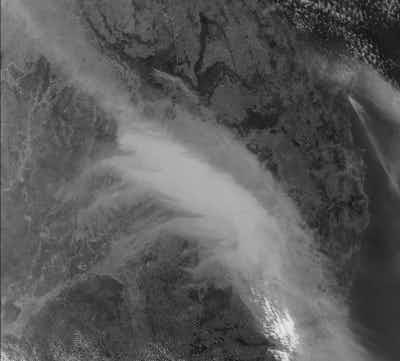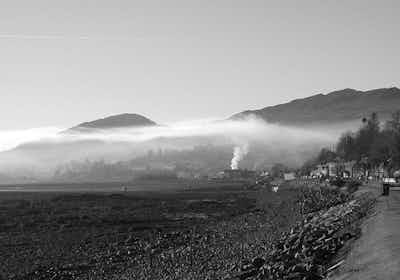Weather not only affects our day to day lives in terms of whether it is going to be hot or cold, wet or dry or windy, but it also plays an important role in determining the quality of the air over a neighbourhood, suburb, city or even a region.
Bad air quality over an area is usually caused by a combination of factors. Communities near industrial facilities and major roads typically have worse air quality than more remote communities, mainly because they are closer to emission sources. However, weather has a major impact on air quality in industrial, urban as well as rural areas through that action of several elements: wind, temperature, sunshine and rainfall.
Areas near industrial facilities
On a local scale, for example near industrial areas or major roads (cities), wind will normally “flush” the pollutants such as carbon monoxide, sulfur dioxide (SO2), nitrogen oxide (NO), nitrogen dioxide (NO2) and PM2.5 (particles with diameters less than 2.5 µm or 0.0025 mm, 20 times smaller than the diameter of a human hair) away and replace them with cleaner air from elsewhere.
However, a lack of wind (i.e. calm conditions) leads to a build-up of air pollution in areas where pollution sources are located. If temperatures are cold at ground level with a warmer layer above (called a temperature inversion), as usually happens on calm, clear winter nights and mornings, pollutants will be trapped by this “lid”, causing increased pollution levels at the surface.

The visible effects of temperature inversion
Ozone (a toxic gas) is formed when nitrogen oxides (NOx), carbon monoxide (CO) and volatile organic compounds (VOCs), such as xylene, react in the atmosphere in the presence of sunlight. This process is known as photochemical ozone formation. The ozone can then react with nitrogen oxide (NO) to form nitrogen dioxide (NO2, a pollutant causing respiratory problems).
Rain cleansing the atmosphere of pollutants
Rain often cleans the atmosphere of pollutants by washing out particles and dissolving gases in raindrops as they fall. In this process, the raindrops impact with the particles or absorb the gases as they fall past them, and hence bring the pollutants to the earth’s surface.
Acid rain forms when sulphur dioxide and nitrogen oxides emitted into the atmosphere react with water, oxygen and other chemicals to form sulfuric and nitric acids, particularly in regions with heavy emissions from fossil fuels that contain sulphur. The emissions then mix with water and other materials before falling to the ground as acid rain. Prolonged exposure to acid rain may result in vegetation damage or changes to soil acidity.
Dry regions, dust storms, and extreme fires
Dust storms are usually caused by a combination of prolonged dry conditions (i.e. in arid or drought-affected regions) resulting in the exposure of topsoil when vegetation dies back through lack of moisture and/or there is overgrazing by farm or wild animals.
When strong winds blow over large areas of exposed soil, the smaller soil particles (PM10: particles with diameters less than 10 µm) are lifted into the air and can stay suspended there for several days. This affects the air quality in both the immediate area where the dust is suspended and over more distant regions if strong dry winds blow the dust a long way.
For example, recent dust storms embedded in a large atmospheric circulation over eastern Australia blew dust from the interior of the continent across to coastal regions including Sydney and Brisbane, bringing high PM10 concentrations and poor air quality to areas well over 1000 km from the source region.

A huge dust storm and smoke from bush fires blow over New South Wales and Queensland, Australia in 2009
A topical issue for western North America and many parts of Australia, indeed many parts of the world, recently is the effect of extreme weather conditions on wildfire or bushfire activity and behaviour.
Apart from the very dramatic impact on life and property, sustained hot dry and strong winds can create the conditions for huge quantities of emissions from large fires that can lead to poor air quality hundreds of kilometres from the fire fronts. The acute effects on air quality from some fires are a major cause of public health concern.
Preparing for impact from air quality and weather events
Effective monitoring of both air quality and weather impacts in tandem can protect community health from air quality events such as a dust storm or wildfire. The ability for city officials or local regulators to visualise data helps them identify areas of concern in urban environments, but also plan ahead to avoid negative impact.
Envirosuite continuously collects high definition weather data in parallel with air quality data from local monitors and sensors. If there is a risk, city officials are now able to act quicker than ever before.
Our predictive weather models combine hyperlocal forecast data with 3D spatial mapping and minute-level time stamping, so officials can use weather to their advantage and know its impact on localities under their jurisdiction.
Detailed risk reports out to 72 hours can be delivered to their inbox daily, with intuitive colour-coded reports and alerts, allowing better preparation to avoid or manage impacts on the community.
